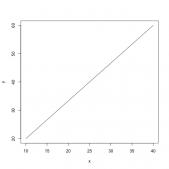之前寫的博客中有提及過如何在 R 語言中繪制矢量圖,然后用于論文引用。但沒有專門開一篇博客來進行說明比較,這里重新開一篇博客來進行說明。
通常保存為矢量圖可能大多數時候是為了論文中的引用,所以格式一般為 EPS, PDF 這兩種格式,這里也主要針對這兩種格式進行說明。
1. R 中自帶的默認繪圖
通常我們使用 plot(), lines(), points(), hist() 等一些 R 中自帶的繪圖工具,如果我們想要將圖片儲存為矢量圖的 PDF 格式應該怎么做呢?
1) PDF 格式
|
1
2
3
4
5
6
7
|
pdf("example1.pdf", width = 4.0, height = 3.0)plot(rnorm(100), main="Hey Some Data") # 自己的繪圖函數# ...# ...dev.off() |
非常簡單,只需用到 pdf() 函數即可。
2) EPS 格式
|
1
2
3
4
5
6
7
8
|
setEPS()postscript("example1.eps", width = 4.0, height = 3.0)plot(rnorm(100), main="Hey Some Data") # 自己的繪圖函數# ...# ...dev.off() |
eps 格式相對復雜,需用到 setEPS() 與 postscript() 函數。
2. ggplot 繪圖
利用 ggplot 繪制矢量圖就相對更加簡單了,每種方式都只需在最后加上一行代碼即可。
假設我們先利用 ggplot 進行繪圖(用例子中的圖):
|
1
2
3
4
5
6
7
8
9
10
11
12
13
14
15
|
library(ggplot2)# Generate some sample data, then compute mean and standard deviation# in each groupdf <- data.frame( gp = factor(rep(letters[1:3], each = 10)), y = rnorm(30))ds <- plyr::ddply(df, "gp", plyr::summarise, mean = mean(y), sd = sd(y))# The summary data frame ds is used to plot larger red points on top# of the raw data. Note that we don't need to supply `data` or `mapping`# in each layer because the defaults from ggplot() are used.ggplot(df, aes(gp, y)) + geom_point() + geom_point(data = ds, aes(y = mean), colour = 'red', size = 3) |
1) PDF 格式
這時我們要儲存為 PDF 格式的圖,只需在上述繪圖語句后面運行下述語句即可:
|
1
|
ggsave("example2.pdf", width = 4.0, height = 3.0) |
2) EPS 格式
而 EPS 格式需要多一個參數: device = cairo_ps
|
1
|
ggsave("example2.eps", width = 4.0, height = 3.0, device = cairo_ps) |
以上就是R語言存儲矢量圖實現方式的詳細內容,更多關于R語言存儲矢量圖的資料請關注服務器之家其它相關文章!
原文鏈接:https://kanny.blog.csdn.net/article/details/100152389















